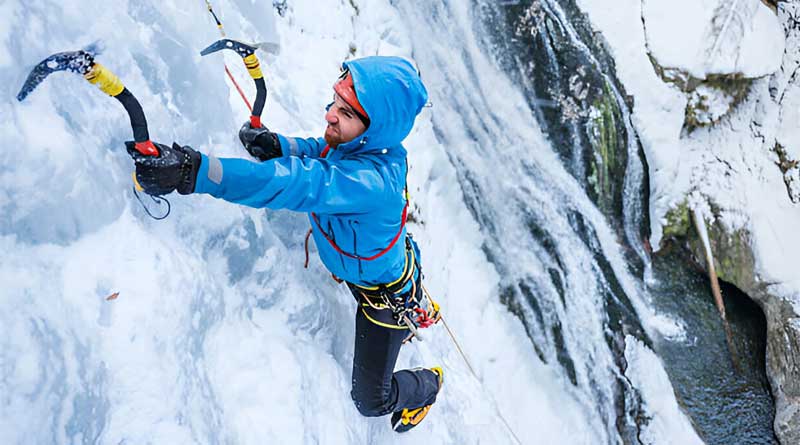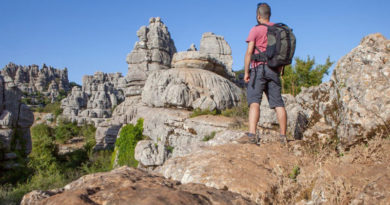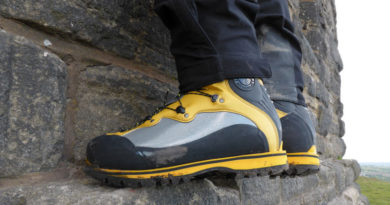Best Mountaineering Ice Axes of 2025
When tackling tough mountain climbs, having the right tools is essential. One of the most important is a mountaineering ice axe. This tool helps you navigate icy terrain, providing both support and safety. Whether you’re a beginner or an experienced mountaineer, choosing the best ice axe can make a big difference in your performance. A high-quality ice axe offers durability, control, and stability, all of which are vital when scaling challenging peaks. In this guide, we’ll explore the best mountaineering ice axes on the market. We’ll compare their features, pros, and cons to help you find the perfect one for your needs.
1. PETZL Gully

-
Weight: 385 g (50 cm)
-
Shaft material: Aluminium
-
Pick material: Chromoly steel
-
Type: Technical ice axe for steep and mixed climbing
The PETZL Gully is a lightweight, versatile ice axe designed for technical alpine climbing. With its aluminium shaft and chromoly steel pick, the Gully strikes a balance between durability and lightness, making it ideal for steep and mixed terrain. The axe is easy to use with a comfortable grip and an ergonomic design that helps reduce fatigue during long climbs.
On the mountain, the Gully excels in demanding conditions, offering excellent performance in both ice and mixed climbing. The design is streamlined and compact, making it a reliable tool when speed and efficiency are key. While the pick is designed to penetrate hard ice effectively, its lightweight nature can sometimes make it less stable in very firm ice compared to heavier models.
Pros:
-
Lightweight design for alpine and technical climbing
-
Durable chromoly steel pick
-
Ergonomically designed for comfort during long climbs
-
Ideal for steep and mixed terrain
Cons:
-
Less stability in extremely hard ice
-
Shaft may not withstand heavy impact in very hard conditions
2. Grivel GZERO

-
Weight: 375 g (50 cm)
-
Shaft material: Aluminium
-
Pick material: Chromoly steel
-
Type: Technical climbing axe for ice and mixed terrain
The Grivel GZERO is an incredibly lightweight and sleek ice axe designed for technical climbing. It features a chromoly steel pick that provides excellent penetration on both ice and mixed surfaces, making it a great choice for climbers looking to tackle steep, challenging routes. Its lightweight construction and the design allow for efficient handling without compromising on durability.
The GZERO also features a robust, ergonomic shaft made from aluminium, which is durable yet light. The tool’s design allows for excellent balance, and the sharp pick ensures reliable performance on icy terrain. However, the GZERO lacks some of the features found in heavier, more technical axes, such as a more aggressive pick, which may affect its performance in more demanding ice conditions.
Pros:
-
Ultra-light design for high-speed alpine climbs
-
Chromoly steel pick offers solid penetration
-
Ergonomic aluminium shaft for comfort
-
Versatile for both ice and mixed climbing
Cons:
-
Lacks the aggression of heavier picks for tough ice
-
Less robust in very challenging conditions
3. Trango Raptor

-
Weight: 480 g (50 cm)
-
Shaft material: Aluminium
-
Pick material: Steel
-
Type: Technical ice axe for alpine climbing
The Trango Raptor is a solid choice for technical climbers who need a versatile and reliable ice axe. It features an aluminium shaft, which offers a good balance between weight and strength, and a steel pick that performs well on ice and mixed terrain. The axe’s design includes a slightly curved shaft that provides a more natural swing, increasing its usability on steep, technical routes.
While the Trango Raptor excels in handling, it may not be as well-suited for ice climbing in extremely cold or hard conditions due to its less aggressive pick. However, its overall balance, weight, and functionality make it an excellent choice for climbers who want an all-around axe for technical alpine climbs, particularly when tackling moderate to difficult routes.
Pros:
-
Balanced weight and strength for efficient use
-
Comfortable curved shaft for improved swing
-
Solid steel pick for dependable ice penetration
-
Versatile for both ice and mixed climbing
Cons:
-
Less aggressive pick for tough ice conditions
-
Heavier compared to other technical ice axes
4. Blue Ice Blackbird

-
Weight: 350 g (50 cm)
-
Shaft material: Aluminium
-
Pick material: Stainless steel
-
Type: Lightweight technical axe for mixed and ice climbing
The Blue Ice Blackbird is a highly specialized, ultra-light technical ice axe that caters to the needs of alpine and ice climbers looking for performance and weight savings. With a stainless steel pick and an aluminium shaft, it offers excellent durability and penetration, allowing it to perform well on both ice and mixed terrain. The design is sleek and minimalist, reducing weight without sacrificing functionality.
Its lightweight construction ensures that climbers can maintain control and precision, even on steep and challenging routes. However, some users have noted that the axe is best suited for less technical routes due to its design, which can be less forgiving on harder ice or mixed terrain compared to heavier axes.
Pros:
-
Lightweight design ideal for fast ascents
-
Durable stainless steel pick
-
Minimalist design reduces fatigue
-
Good performance on ice and mixed terrain
Cons:
-
Less suitable for very hard or technical ice
-
Minimalist design may sacrifice comfort in some cases
5. Corsa Alpine

-
Weight: 270 g (50 cm)
-
Shaft material: Aluminium
-
Pick material: Steel
-
Type: Lightweight ice axe for mountaineering
The Corsa Alpine is one of the lightest ice axes on the market, making it ideal for mountaineering and ski mountaineering where weight is a critical factor. Its aluminium shaft provides durability without unnecessary weight, and the steel pick ensures solid performance on snow and ice. The axe is highly responsive, making it perfect for quick self-arrest and efficient use during mountain ascents.
While the Corsa Alpine excels in weight-saving, its lightweight nature does limit its performance in steep, technical ice conditions. For more demanding climbs, climbers may prefer a heavier axe with more aggressive features. Still, for those looking for a reliable tool on moderate terrain, the Corsa Alpine is hard to beat.
Pros:
-
Extremely lightweight for easy carrying
-
Steel pick offers solid ice penetration
-
Ideal for ski touring
-
Highly responsive and efficient
Cons:
-
Less effective on steep or technical ice
-
Lacks aggressive features for challenging conditions
6. Black Diamond Raven

-
Weight: 460 g (50 cm)
-
Shaft material: Aluminium
-
Pick material: Steel
-
Type: Classic mountaineering ice axe
The Black Diamond Raven is a time-tested, classic mountaineering ice axe designed for simplicity and reliability. Featuring a solid steel pick and an aluminium shaft, it offers dependable performance for general mountaineering and glacier travel. The Raven excels in versatility, providing the right balance of weight and durability for climbers on moderate to low-angle terrain.
However, its more traditional design may not suit those seeking cutting-edge features for steep, technical climbing. While the Raven performs well on snow and easy ice, it may lack the advanced ergonomics and precision of more modern technical axes.
Pros:
-
Reliable, time-tested design
-
Steel pick offers dependable ice penetration
-
Versatile for general mountaineering
-
Durable aluminium shaft
Cons:
-
Less suitable for steep, technical climbing
-
Lacks advanced ergonomic features
7. PETZL Glacier

-
Weight: 500 g (50 cm)
-
Shaft material: Aluminium
-
Pick material: Steel
-
Type: General mountaineering ice axe
The PETZL Glacier is a sturdy and reliable ice axe designed for general mountaineering. It features a durable aluminium shaft and a steel pick, providing solid performance on a variety of conditions, from snow slopes to icy sections. Its ergonomic design ensures comfort during extended use, making it a good option for climbers seeking a dependable tool for long climbs and glacier travel.
While the Glacier offers great durability and ease of use, its weight and design may not be as ideal for steep, technical ice routes. For mountaineers focusing on higher, more technical climbs, a lighter, more specialized tool may be a better option.
Pros:
-
Solid design for general mountaineering
-
Ergonomic handle for comfort
-
Durable steel pick
-
Reliable performance in snow and ice
Cons:
-
Heavier than more technical ice axes
-
Not suited for steep or technical ice climbing
How to Choose Mountaineering Ice Axes
Choosing the right ice axe is a critical decision for any mountaineer, whether you’re a beginner or an experienced climber. The ice axe is an essential tool for self-arrest, navigation, and technical climbing on snow and ice-covered terrain. In this article, we’ll discuss the factors to consider when selecting an ice axe, the different types available, and how to match the axe to your climbing style and objectives.
1. Understand the Types of Ice Axes
There are several types of ice axes, each designed for different purposes. Understanding these will help you narrow down your choices.
a. General Mountaineering Axes
These are versatile axes designed for various uses, including self-arrest, moderate climbing, and glacier travel. They typically feature a straight shaft with a comfortable grip and a versatile pick. General mountaineering axes are ideal for beginners and intermediate climbers who need a reliable tool for basic snow and ice routes.
b. Technical Climbing Axes
These axes are designed for more challenging, vertical ice climbing and mixed routes. Technical axes are typically shorter, lighter, and have more specialized picks with a steeper curve, which allows for better penetration into hard ice. They often feature a more ergonomic shaft and advanced handle designs for precise control and energy efficiency. If you’re planning to climb steep ice or mixed terrain, a technical axe is the way to go.
c. Hybrid Axes
Hybrid axes combine elements of both general mountaineering and technical axes. They are designed for climbers who tackle moderate snow slopes but occasionally encounter vertical ice or mixed terrain. Hybrid axes are versatile and offer the best of both worlds—comfort for glacier travel and precision for technical climbing.
d. Specialized Axes
For advanced mountaineers, specialized axes are designed for specific disciplines, such as ice waterfall climbing or alpine mixed climbing. These axes often have very specific features, like adjustable shafts, specialized grips, or extreme pick angles, tailored to the most demanding climbing environments.
2. Determine the Length of the Ice Axe
The length of your ice axe will depend on several factors, including your height, climbing style, and the type of terrain you’ll be on. As a general rule, the length should allow you to comfortably use the axe for self-arrest, support while ascending or descending, and general movement on snow or ice.
a. For General Mountaineering
If you’re planning to travel on snow slopes or glaciers, the ice axe length is typically based on your height. A common guideline is that the axe should reach from the ground to just below your armpit when the blade is planted in the snow at a 45-degree angle. For taller climbers, you may need a longer axe (around 70–75 cm), while shorter climbers may find an axe in the 60–65 cm range to be more suitable.
b. For Technical Climbing
For ice climbing and mixed terrain, the axe should be shorter and more compact. Typically, a length between 50 cm and 60 cm is ideal for technical climbers, depending on personal preference and the type of routes you’re tackling. Shorter axes allow for more precise placement and better maneuverability in vertical ice.
3. Pick and Blade Design
The pick and blade are arguably the most critical parts of an ice axe. Their design, including the shape, length, and material, influences the axe’s performance on various surfaces.
a. Pick Shape
The pick should be designed for your specific activity. For general mountaineering, a straight or slightly curved pick is ideal, as it offers balanced performance in both snow and ice. For technical climbing, a steeper, more aggressively curved pick helps with penetration in harder ice. A pick with teeth or serrations along the front edge will also offer better traction in mixed climbing conditions.
b. Blade Material
Modern ice axe blades are typically made from high-quality steel, such as chromoly or stainless steel. Stainless steel is corrosion-resistant, while chromoly steel offers increased strength and durability, particularly in hard ice. Some axes use materials like carbon steel for weight savings, but these may be prone to rust if not maintained properly.
c. Blade Features
Some ice axes come with additional features, such as an aggressive spike or a hole in the blade for attaching a leash or other climbing accessories. These added features are particularly useful in technical climbing, where precision and reliability are critical.
4. Shaft Design and Material
The material and design of the shaft can significantly affect the weight, durability, and comfort of your ice axe. Most modern ice axes have shafts made from lightweight aluminum or carbon fiber. Aluminum is durable and offers good value, but it may not be as strong as carbon fiber. Carbon fiber shafts are lighter and stiffer, but they can be more expensive and may not be as robust as aluminum in extreme conditions.
a. Ergonomics
When choosing an ice axe, it’s important to consider how the shaft feels in your hand. Many axes feature ergonomic grips with rubber or plastic covering to enhance comfort and control, especially during prolonged use. Some technical axes have more specialized handles that provide a better grip for ice climbing, such as curved or contoured shafts that improve ergonomics.
b. Shaft Length
As mentioned earlier, the length of the shaft plays an important role in overall comfort. However, some axes also feature adjustable shafts for greater versatility. These axes are ideal for climbers who engage in a variety of mountaineering activities and need a tool that can adapt to different situations.
5. Leash or Strap Considerations
A leash or strap is essential for keeping your ice axe secure during climbing. Most modern ice axes come with a wrist strap, but the type of strap can vary. A traditional leash will secure the axe to your wrist, preventing it from falling if you lose your grip, which can be a lifesaver during steep climbs.
Some advanced climbers prefer leashless systems, especially for ice climbing, where quick transitions and minimal interference with the axe are needed. Leashless axes often have a more minimalistic design and allow for more freedom of movement. However, if you’re new to mountaineering, starting with a leash may offer more security and peace of mind.
6. Weight Considerations
The weight of the ice axe is another key factor to consider. Lighter axes are easier to handle over long periods, making them ideal for general mountaineering and glacier travel, where self-arrest and movement on moderate terrain are required. However, heavier axes are often preferred for technical climbing, where the added weight can provide better control and stability on steep ice.
7. Brand and Price
There are many brands that produce high-quality ice axes, including Petzl, Black Diamond, Grivel, and Camp. Each brand offers a range of options, from entry-level models to advanced, highly specialized axes. While it’s tempting to go for a budget option, investing in a quality axe from a reputable brand is highly recommended for both performance and safety.
Conclusion
Choosing the right ice axe comes down to understanding your climbing style, terrain, and needs. For general mountaineering, look for an axe with a comfortable shaft length, a versatile pick, and durable construction. For technical climbing, prioritize a shorter, lightweight axe with an aggressive pick design. Ensure that the shaft design is ergonomic and lightweight enough for comfort, and consider adding a leash for extra security.
The right ice axe is a valuable companion for any mountaineer, and choosing wisely can improve your climbing experience and safety. With the proper knowledge of the features and design elements, you’ll be well-equipped to choose the perfect axe for your next adventure.




